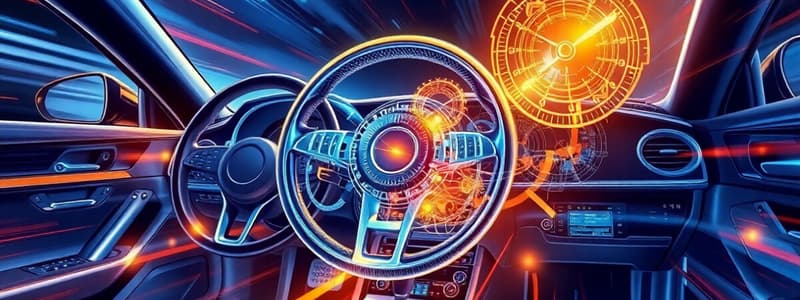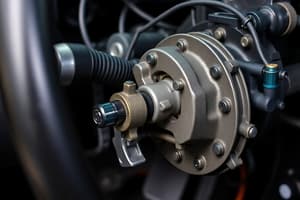Podcast
Questions and Answers
Which of the following is the MOST accurate description of 'driveability' in the context of vehicle dynamics?
Which of the following is the MOST accurate description of 'driveability' in the context of vehicle dynamics?
- The fuel efficiency of the vehicle under various driving conditions.
- The driver's perception of how well the vehicle responds, combined with the vehicle's physical response to driver inputs. (correct)
- The maximum speed a vehicle can achieve on a test track.
- The ability of a vehicle to handle off-road terrains and obstacles.
What primary purpose does positive caster serve in a vehicle's steering system?
What primary purpose does positive caster serve in a vehicle's steering system?
- Increases the vehicle's turning radius for better maneuverability.
- Creates a restoring moment that helps the wheels return to a straight-ahead position. (correct)
- Minimizes the impact of road imperfections on the steering wheel.
- Reduces the amount of torque needed to turn the steering wheel.
In a steering system, where is the kingpin typically located and what is its primary function?
In a steering system, where is the kingpin typically located and what is its primary function?
- Attached to the wheel hub, controlling wheel speed.
- Integrated within the engine block, adjusting engine timing based on steering input.
- Positioned in the vehicle's chassis, absorbing shocks from the road.
- Attached to the stub axle, allowing rotation in a collar connected to the suspension system. (correct)
What is the primary advantage of using recirculating ball bearings in a steering system?
What is the primary advantage of using recirculating ball bearings in a steering system?
How does an electric power-assisted steering (EPAS) system primarily contribute to fuel efficiency compared to a hydraulic power-assisted steering system?
How does an electric power-assisted steering (EPAS) system primarily contribute to fuel efficiency compared to a hydraulic power-assisted steering system?
What is the function of 'toe' in vehicle alignment, and how does toe-in typically affect rear-wheel-drive vehicles?
What is the function of 'toe' in vehicle alignment, and how does toe-in typically affect rear-wheel-drive vehicles?
Why is minimizing 'play' in steering controls considered a crucial steering requirement?
Why is minimizing 'play' in steering controls considered a crucial steering requirement?
What is scrub radius and where is it measured?
What is scrub radius and where is it measured?
When discussing steering geometry, what does 'camber' refer to?
When discussing steering geometry, what does 'camber' refer to?
Why would a steering system be designed to return wheels toward the straight-ahead position when the driver releases the steering wheel??
Why would a steering system be designed to return wheels toward the straight-ahead position when the driver releases the steering wheel??
Flashcards
Steering Functions
Steering Functions
Positive control of wheel steering angle
Steering Requirements
Steering Requirements
Minimize play, reduce road impact, lower torque, straighten wheels when released
Driveability
Driveability
Driver's perception and vehicle's physical response to driver inputs.
Steering Components
Steering Components
Signup and view all the flashcards
Camber
Camber
Signup and view all the flashcards
Steering Axis Inclination
Steering Axis Inclination
Signup and view all the flashcards
Scrub Radius
Scrub Radius
Signup and view all the flashcards
Caster
Caster
Signup and view all the flashcards
Toe
Toe
Signup and view all the flashcards
Pittman Arm / Drag Link
Pittman Arm / Drag Link
Signup and view all the flashcards
Study Notes
- Study notes on steering and handling, components, and related mechanisms.
Steering System
- Provides positive control of wheel steering angle.
- Maintains proper wheel geometry during cornering for predictable and stable handling.
- Ensures good driveability.
Driveability
- Encompasses the driver's perception of the vehicle and its responsiveness.
- Considers factors like movement and sound relative to expectations.
- Includes the vehicle's physical response to driver inputs.
- Addresses acceleration, braking, cornering, and stability.
Steering Requirements
- Minimizes "play" in steering controls.
- Reduces road impact transmission to the driver's hands.
- Prevents loss of grip on the steering wheel.
- Decreases input torque requirements.
- Returns wheels to a straight-ahead position upon release.
Steering Cornering Behavior
- Acceptable cornering behavior maintains a smooth, consistent turning path.
- Unacceptable cornering behavior is exaggerated.
SAE Vehicle Coordinate System
- Considers up to 17 degrees of freedom, relative to three main axes, for a moving vehicle.
Steering Components
- Wheel attached to stub axle.
- Stub axle attached to Kingpin.
- Kingpin rotates in a collar attached to the suspension system.
- Modern systems often feature a virtual kingpin.
- Rotation is achieved by a lever, such as a tie-rod arm or steering arm.
- Steering arm integrates with the steering knuckle.
Steering Geometry Definitions
- Camber: The angle the wheel deviates from vertical when viewed from the front.
- Positive camber: the top of the wheel is away from the vehicle.
- Steering Axis Inclination: Kingpin angle relative to vertical from the front.
- When the wheel is turned, it moves down relative to the body, resulting in the most stable position being straight-ahead.
- Scrub Radius: Distance between tire centerline and steering axis intersection.
Caster
- The kingpin angle viewed from the side.
- Positive caster: the top of the kingpin behind the bottom.
- Positive caster creates a rolling resistance force on contact patch.
- The force is behind the intersection of steering axis and the ground.
-
- Causes a restoring moment, which rotates the tire towards the x-axis even without force.
Toe
- Wheel center-plane angle relative to "straight ahead" (exaggerated).
- Toe-in is typical for rear-wheel drive.
- Rolling resistance pushes wheels rearward towards "true".
- Toe-out is typical for front-wheel drive.
- Tractive force pushes wheels forward toward "true".
Steering Mechanisms: Pittman Arm and Drag Link
- Utilizes recirculating ball bearings.
- The ball bearings minimize friction.
- Reduces the input force needed.
- Features a relatively large amount of "play" because of space between balls.
Steering Mechanisms: Rack & Pinion
- Includes a pinion and a rack.
Power Steering: Hydraulic "Power-Assisted"
- Reduces the input force required.
- Produces no net force when the wheel is straight.
- Prevents reducing input too much.
- Applies hydraulic pressure through a rotary spool valve.
- Oversized and inefficient due to belt-driven hydraulic pump.
- The pump is sized to provide maximum assist at low speed.
Power Steering: Electric Power Assisted
- Uses electronic control for variable assist based on vehicle speed.
- Only draws power when needed.
- Reduces parasitic losses at highway speeds.
- Results in an estimated 1-2 mpg increase in fuel efficiency based on EPA estimates.
- Offers flexibility in component location.
Studying That Suits You
Use AI to generate personalized quizzes and flashcards to suit your learning preferences.




